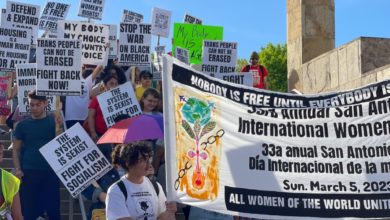This month we celebrate the 100th anniversary of International Women’s Day. It is a day for international solidarity and celebration of the political, social and economic achievements of women and a reminder of the ongoing struggle for complete gender equality.
 A Soviet poster celebrating working women. International Women’s Day demontrations sparked the first stages of the 1917 Russian Revolution. |
The oppression of women arose with the emergence of the early accumulation of wealth and the development of class societies. As men asserted control over the means of production and the resulting surplus, women were confined to the home, reduced to the property of their husbands. Women became valued for the children they could bear, not for their intrinsic value as human beings and contributions to society as a whole.
The form of women’s oppression has changed throughout time, but it has remained a constant feature of class society. The era of industrial capitalism, for instance, pulled women out of the home and into the official workforce. This provided the basis for the modern women’s rights movement and many impressive reforms won through struggle over the last century. But women’s oppression and sexism remain; we have yet to regain our status as equal members of society.
Just look at the current economic crisis, in which women— and especially women from oppressed communities—are suffering the most.
Over half of the 37 million Americans living in poverty today are women. For families, the poverty rates are highest for those headed by single women, particularly Black or Latina. In 2008, 28.7 percent of households headed by single women were poor. About 90 percent of welfare recipients are women. In fact, the gap in poverty rates between men and women is wider in the United States than anywhere else in the Western world.
Women continue to earn less than men in the workplace. White women earn 77 cents on the dollar to their male counterparts, and Black and Latina women earn 58 and 57 cents, respectively. That is in addition to the unofficial limitations put on women at the workplace, the so-called “glass ceilings” that keep women from being promoted.
Although it has become taboo to openly suggest that men are superior to women, girls and women are still pressured in a myriad of ways to believe that they are not as intelligent or strong as males. Women are subtly steered away from achieving in math, science and athletics. The media continues to depict women as purely sex objects and “delicate flowers” to be taken care of and protected by men.
Violence against women
Poor women are also among the most vulnerable to violence. A disproportionate percentage of welfare recipients were domestic violence victims, many of whom used welfare as a means of gaining some economic independence from an abusive partner. Support for welfare and domestic violence assistance, however, has been slashed at both the state and federal level.
The level of violence against women continues at appalling rates. More than 2.5 million women experience violence each year, including domestic abuse, rape, harassment, and other forms of gender-based attacks. Four women in the United States die every day by domestic violence. One woman is raped every 45 seconds in the United States. Over time, that comes out to at least one in every three women facing violence in this country over their lives.
These statistics would be much higher if all incidents were reported. It is estimated that only 40 percent of sexual assaults are reported, due to women not wanting to risk the shame, blame or indifference of the police, the courts and society-at-large.
Still without the right to choose
At the same time, millions of women across the country are uninsured or underinsured.
The current Health Care Reform Bill had originally allocated some funding for legal abortions, but that money has been stripped away. In November, by a vote of 240-194, the Democrat-controlled House passed the Stupak-Pitts amendment, which contains language that effectively bars access to safe abortions for working-class women except in cases of rape, incest or to save the life of the mother.
The amendment, sponsored by Democrat Bart Stupak and Republican Joe Pitts, prohibits the use of any federal funds toward a health care plan that covers abortion. It unrealistically allows insurance companies to offer costly supplemental insurance to cover abortion that can be purchased separately by individuals.
If Stupak-Pitts becomes part of a final health care bill signed into law, it will make access to safe abortions an exclusive privilege of the wealthier sectors of society—those who are not suffering from the health care crisis as it is. It represents a great attack on the gains of the women’s right movement and the historic 1973 Roe v. Wade Supreme Court ruling.
Medicaid, which covers one in 10 women and one in five low-income women, has allowed some coverage of abortion for women who qualify, but it has never provided enough. With the national average cost of first-term abortions being $490, this “protected right” has still been largely out of the reach of most working-class women.
All this points to the fact that women above all are in desperate need of universal health care, which allows free abortion on demand, extensive paid family leave, and maternity care geared towards the well-being of the patients and not towards profits for the medical care industry and insurance companies.
Fighting for equality
Millions of women have successfully fought for the right to vote, the right to abortions and better working conditions. We have played critical roles in the struggle for liberation in Latin America, Africa, Asia, the Caribbean, and the entire world.
Women have played an integral part in every struggle for progress, including civil rights, labor rights, immigrant rights, and against imperialist war. In the face of the constant threats and harassment against the LGBT community, women have stood up for their right to live and love freely. Women worldwide have shown that we can and will be leaders and organizers.
But we can find no real equality under the capitalist system, which is rooted in exploitation, squeezing workers for every last cent of profit, while dividing us on the basis of gender, nationality and sexual orientation. The system of patriarchy, which has existed for thousands of years, cannot be effectively dismantled within the confines of such a system.
Working-class women face problems and forms of oppression that working-class men do not. But our liberation requires the overthrow of the social system, and thus requires unity with working-class men who will join with us as equals in our common struggle.
That is the true legacy of International Women’s Day: the fight for women’s liberation and the fight for socialism!






